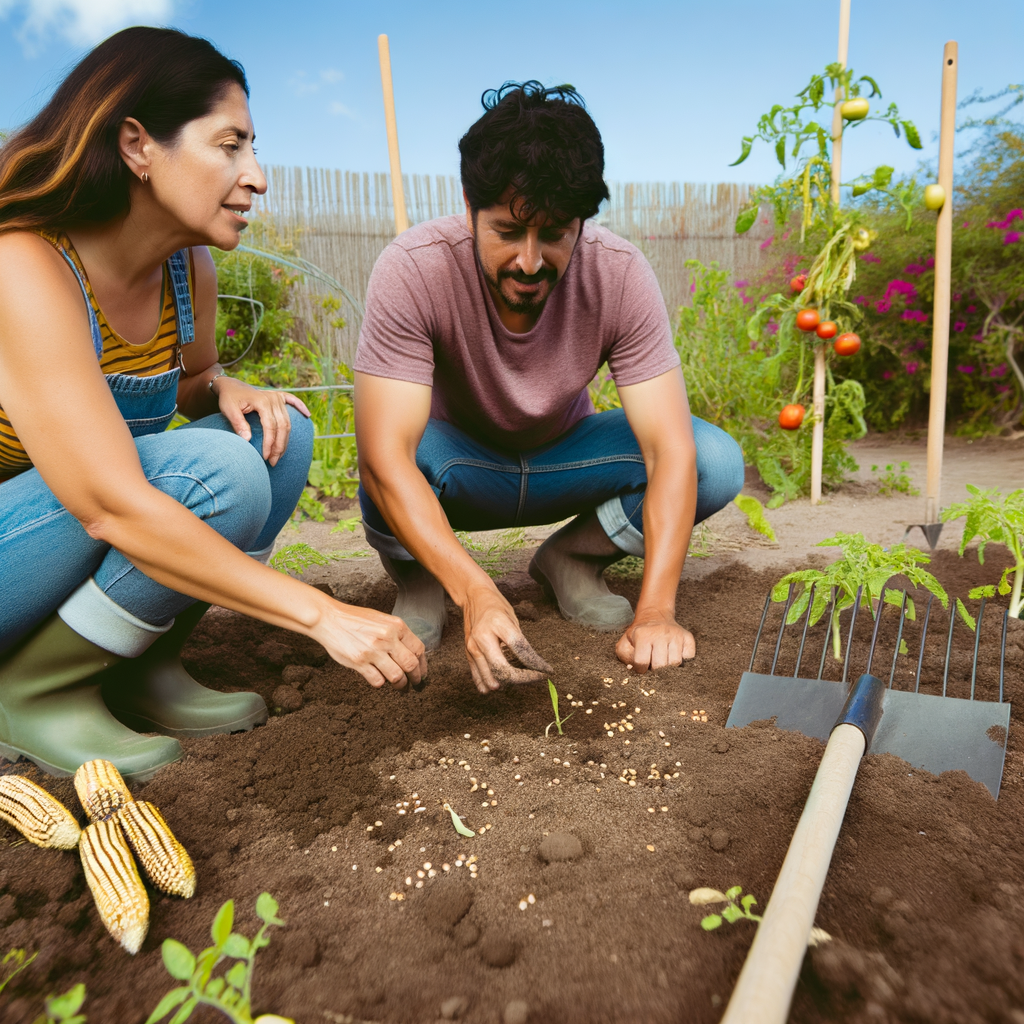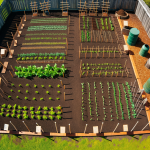Want to break free from the traditional mold and create a beautiful garden without tilling? Look no further, because in this article, we will show you how to do just that.
Gone are the days when tilling was the only way to prepare your garden beds. This outdated method disrupts the soil structure, disturbs beneficial organisms, and leads to soil erosion. So why not try a more sustainable and gentle approach?
In this guide, we will explore alternative methods that allow you to create a stunning garden without ever setting foot on a tiller. From lasagna gardening to raised beds and no-till practices, we will provide you with simple techniques and expert tips to help you break the mold and achieve gardening success.
Whether you are a seasoned gardener or a beginner, this article will empower you to embrace a new way of gardening that is both environmentally friendly and yields beautiful, abundant results. So, let’s dig in and discover how to create a gorgeous garden without tilling!
What is tilling and why is it commonly used in gardening?

Are you tired of the back-breaking work of tilling your garden every year? Want to break free from the traditional mold and create a beautiful garden without all the hassle? Look no further, because in this article, we will show you how to do just that.
Gone are the days when tilling was the only way to prepare your garden beds. This outdated method disrupts the soil structure, disturbs beneficial organisms, and leads to soil erosion. So why not try a more sustainable and gentle approach?
In this guide, we will explore alternative methods that allow you to create a stunning garden without ever setting foot on a tiller. From lasagna gardening to raised beds and no-till practices, we will provide you with simple techniques and expert tips to help you break the mold and achieve gardening success.
Whether you are a seasoned gardener or a beginner, this article will empower you to embrace a new way of gardening that is both environmentally friendly and yields beautiful, abundant results. So, let’s dig in and discover how to create a gorgeous garden without tilling!
The drawbacks of tilling in gardening
Tilling, also known as plowing or cultivation, is the process of turning over the soil in a garden bed using a tiller or other mechanical tools. It has been a common practice in gardening for centuries, believed to improve soil structure, eliminate weeds, and promote nutrient availability. However, tilling is not without its drawbacks.
Tilling disrupts the soil ecosystem by disturbing beneficial organisms such as earthworms, fungi, and bacteria that contribute to soil health. It also breaks up soil aggregates, leading to increased soil erosion and loss of organic matter. Moreover, tilling can create a hardpan layer, hindering root growth and water infiltration. These negative effects have prompted gardeners to seek alternative methods that preserve soil health and reduce labor.
Benefits of gardening without tilling

While tilling may seem like a quick and effective way to prepare your garden beds, it comes with several drawbacks that can have long-term consequences for your garden’s health and productivity.
Firstly, tilling disrupts the soil structure, breaking down soil aggregates and destroying the natural pore spaces that allow air and water to move freely. This compacted soil can lead to poor drainage, root compaction, and decreased nutrient uptake by plants.
Secondly, tilling disturbs the delicate balance of beneficial organisms in the soil. Earthworms, bacteria, fungi, and other microorganisms play a crucial role in decomposing organic matter, cycling nutrients, and improving soil fertility. Tilling can destroy their habitats and disrupt their activities, negatively affecting soil health.
Lastly, tilling promotes soil erosion. When the soil is tilled, it becomes more susceptible to wind and water erosion, leading to the loss of topsoil and valuable nutrients. This erosion can be detrimental to the long-term productivity and sustainability of your garden.
Understanding the no-till gardening approach
Gardening without tilling offers a host of benefits for both your garden and the environment. By embracing alternative methods, you can create a sustainable and thriving garden while reducing labor and minimizing your impact on the soil ecosystem.
One of the primary benefits of no-till gardening is improved soil health. By avoiding the disruption of soil structure, beneficial organisms can thrive, enhancing soil fertility and nutrient cycling. This leads to healthier plants with stronger root systems and increased disease resistance.
No-till gardening also helps to conserve soil moisture. When the soil is left undisturbed, the natural mulch layer created by plant residues and organic matter acts as a protective barrier, reducing evaporation and retaining moisture in the soil. This can be particularly beneficial in dry or arid regions where water conservation is crucial.
Additionally, no-till gardening promotes carbon sequestration. When organic matter is left on the soil surface, it decomposes slowly, allowing carbon to be stored in the soil. This helps to mitigate climate change by reducing greenhouse gas emissions and increasing soil carbon levels.
Preparing your garden for no-till gardening
No-till gardening is a method that focuses on minimizing soil disturbance and maximizing soil health. It involves leaving the soil undisturbed and using natural techniques to improve fertility, control weeds, and manage pests. Understanding the principles of no-till gardening is essential to successfully implement this approach in your garden.
Firstly, it is important to avoid digging or tilling the soil. Instead, focus on building healthy soil by adding organic matter such as compost, leaf mold, or well-rotted manure. This organic matter nourishes the soil, improves its structure, and provides essential nutrients for plant growth.
Secondly, adopt a “no bare soil” policy. Mulching is a key practice in no-till gardening, as it helps to suppress weeds, conserve moisture, and regulate soil temperature. Organic mulches like straw, wood chips, or shredded leaves can be applied around plants to create a protective layer.
Lastly, encourage biodiversity in your garden. By planting a diverse range of flowers, herbs, and vegetables, you can attract beneficial insects and pollinators that help control pests and promote plant health. Companion planting, intercropping, and crop rotation are also effective strategies for pest management in a no-till garden.
Choosing the right plants for no-till gardening
Before you embark on your no-till gardening journey, it is essential to prepare your garden beds properly. This involves clearing any existing vegetation, removing weeds, and improving soil fertility.
Start by removing any weeds or unwanted plants from your garden beds. This can be done manually or by using a natural weed-killer like vinegar or boiling water. Be sure to remove the entire root system to prevent regrowth.
Next, add a layer of organic matter to your garden beds. This can be compost, well-rotted manure, or a mixture of both. Spread a thick layer (around 4-6 inches) evenly over the soil surface, taking care not to disturb the soil underneath.
Once the organic matter is added, you can further enhance soil fertility by incorporating amendments like bone meal, rock phosphate, or kelp meal. These amendments provide essential nutrients that plants need for healthy growth and development.
Finally, apply a layer of mulch over the soil surface to suppress weeds, conserve moisture, and regulate soil temperature. Organic mulches like straw, wood chips, or shredded leaves work best in a no-till garden. Apply a layer of around 2-4 inches, making sure to leave a small gap around the base of plants to prevent rot.
Implementing mulching techniques in no-till gardening
In a no-till garden, it is important to choose plants that are well-suited to this low-disturbance gardening method. Some plants thrive in no-till conditions, while others may struggle to compete with weeds or adapt to the soil structure.
When selecting plants for your garden, consider their growth habits, adaptability, and tolerance to specific environmental conditions. Native plants and heirloom varieties are often well-suited to no-till gardening, as they have evolved to thrive in the local climate and soil conditions.
Additionally, choose plants that have deep root systems, as these can help improve soil structure and nutrient cycling. Plants with shallow roots may struggle to establish themselves in undisturbed soil, especially if it is compacted or lacking in organic matter.
Finally, consider incorporating cover crops into your no-till garden. Cover crops, such as clover, buckwheat, or vetch, can help suppress weeds, improve soil fertility, and prevent erosion. They also add organic matter to the soil when they are turned under or left to decompose.
Managing weeds and pests in a no-till garden
Mulching is a key practice in no-till gardening, as it helps to suppress weeds, conserve moisture, and regulate soil temperature. Implementing effective mulching techniques can greatly enhance the success of your no-till garden.
Start by applying a thick layer of mulch around your plants, ensuring that the soil surface is completely covered. This prevents weed seeds from germinating and competing with your plants for nutrients and water. It also acts as a barrier, reducing evaporation and conserving soil moisture.
Choose organic mulches that will break down over time and contribute to soil fertility. Straw, wood chips, shredded leaves, or grass clippings are all excellent options. Avoid using plastic mulch, as it can hinder the exchange of gases between the soil and the atmosphere.
It is important to replenish your mulch periodically to maintain its effectiveness. As the mulch decomposes, it will gradually break down and become incorporated into the soil. Add a fresh layer of mulch as needed to maintain a thickness of around 2-4 inches.
No-till gardening success stories and testimonials
Weeds and pests can be a challenge in any garden, but with the right strategies, you can effectively manage them in a no-till garden without resorting to harmful chemicals.
One of the most effective ways to control weeds in a no-till garden is through the use of mulch. Mulch acts as a physical barrier, preventing weed seeds from germinating and competing with your plants for resources. Regularly inspect your garden beds and remove any emerging weeds by hand, taking care to remove the entire root system.
Encouraging biodiversity in your garden can also help control pests naturally. Planting flowers that attract beneficial insects, such as ladybugs, lacewings, and hoverflies, can help keep pest populations in check. Additionally, avoid monocultures and practice crop rotation to disrupt pest life cycles and reduce the risk of infestations.
If pest problems persist, consider using organic pest control methods such as insecticidal soaps, neem oil, or biological controls like nematodes or beneficial fungi. These methods target specific pests while minimizing harm to beneficial insects and the environment.
Conclusion: Embracing a new approach to garden without tilling
No-till gardening has gained popularity among gardeners around the world, with many success stories and testimonials highlighting its numerous benefits.
John, a passionate gardener from California, transformed his backyard into a no-till oasis. By incorporating mulching techniques and using cover crops, he was able to improve soil fertility and reduce water usage. His garden now thrives with vibrant flowers, healthy vegetables, and an abundance of beneficial insects.
Jane, a beginner gardener from New York, decided to try no-till gardening after reading about its benefits. With minimal experience, she was able to create a beautiful garden by following the simple techniques outlined in this article. She now enjoys spending time in her garden, watching it flourish without the need for tilling or excessive maintenance.
These success stories and testimonials demonstrate that garden without tilling is not only a sustainable and environmentally friendly approach, but also a rewarding and fulfilling gardening experience. Check put our article Gardening without Digging.









